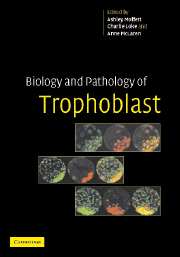Book contents
- Frontmatter
- Contents
- List of contributors
- List of participants
- Preface
- Chair's introduction
- 1 Trophoblast cell fate specification
- 2 Stem cells: pluripotency and extraembryonic differentiation in the mouse
- 3 Epigenetic regulation of trophoblast development
- 4 Regulation of X-chromosome inactivation in relation to lineage allocation in early mouse embryogenesis
- General discussion I
- General discussion II
- 9 Molecular signalling in embryo–uterine interactions during implantation
- 10 Trophoblast and pre-eclampsia
- 11 Trophoblast and uterine mucosal leukocytes
- 12 Immunology of trophoblast: a reappraisal
- Final general discussion
- Index
- Plate section
- References
10 - Trophoblast and pre-eclampsia
from General discussion II
Published online by Cambridge University Press: 07 August 2009
- Frontmatter
- Contents
- List of contributors
- List of participants
- Preface
- Chair's introduction
- 1 Trophoblast cell fate specification
- 2 Stem cells: pluripotency and extraembryonic differentiation in the mouse
- 3 Epigenetic regulation of trophoblast development
- 4 Regulation of X-chromosome inactivation in relation to lineage allocation in early mouse embryogenesis
- General discussion I
- General discussion II
- 9 Molecular signalling in embryo–uterine interactions during implantation
- 10 Trophoblast and pre-eclampsia
- 11 Trophoblast and uterine mucosal leukocytes
- 12 Immunology of trophoblast: a reappraisal
- Final general discussion
- Index
- Plate section
- References
Summary
Introduction
In this chapter, the importance of trophoblast in generating the maternal signs and symptoms that comprise the syndrome of pre-eclampsia will be discussed, but not the processes of placentation in early pregnancy that may be important in the preclinical phases of the disorder. pre-eclampsia is a potentially dangerous and highly variable complication of the second half of pregnancy, labour or the early puerperium. It has been known for nearly 100 years that it originates in the placenta (Holland 1909). The presence of a placenta is both necessary and sufficient to cause the disorder (Redman 1991). A fetus is not required as pre-eclampsia can occur with hydatidiform mole (Chun et al. 1964). A uterus is probably not required because pre-eclampsia may develop with abdominal pregnancy (Piering et al. 1993). Central to management is delivery, which removes the causative organ, namely the placenta.
The maternal illness of pre-eclampsia was originally thought to be caused primarily by generalised maternal endothelial activation and dysfunction (Roberts et al. 1989). Later this concept was broadened by incorporating endothelial dysfunction as one of several components of a maternal systemic inflammatory response in pre-eclampsia (Redman et al. 1999).
A key feature is that systemic inflammation is not only characteristic of the pre-eclamptic woman but an intrinsic part of every normal pregnancy, which becomes most evident in the third trimester (Redman et al. 1999). The inflammatory response of pre-eclampsia does not differ in type, but only in degree, being more intense.
- Type
- Chapter
- Information
- Biology and Pathology of Trophoblast , pp. 194 - 222Publisher: Cambridge University PressPrint publication year: 2006



